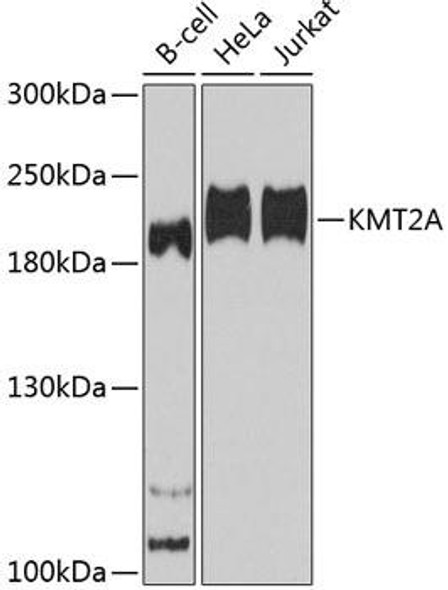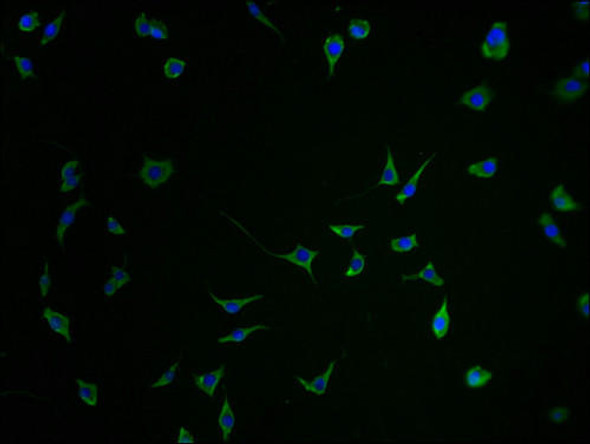Description
KMT2A Antibody (PACO07353)
The KMT2A Antibody (PAC007353) is a valuable tool for researchers studying the KMT2A protein, also known as Mixed Lineage Leukemia (MLL). This antibody is specifically designed for use in Western blot applications and is highly reactive with human samples. Raised in rabbits, the KMT2A Antibody binds to the KMT2A protein, enabling detection and analysis in various cell types.KMT2A is a key player in gene regulation and chromatin remodeling, making it essential for normal cellular function and development. Mutations or dysregulation of KMT2A are linked to various cancers, including leukemia, making it an important target for cancer research.
By studying the activity of KMT2A with the help of this antibody, researchers can gain insights into its role in disease progression and potentially discover new therapeutic targets for cancer treatment.With its high specificity and sensitivity, the KMT2A Antibody (PAC007353) is an invaluable tool for scientists investigating the function of KMT2A in health and disease. Its use in research can help advance our understanding of gene regulation and chromatin dynamics, ultimately leading to new discoveries in cancer biology and treatment.
| Antibody Name: | KMT2A Antibody (PACO07353) |
| Antibody SKU: | PACO07353 |
| Size: | 50ug |
| Host Species: | Rabbit |
| Tested Applications: | ELISA, IHC |
| Recommended Dilutions: | ELISA:1:10000-1:20000, IHC-p:1:50-1:300 |
| Species Reactivity: | Human, Mouse, Rat |
| Immunogen: | Synthetic peptide from human protein at AA range: 3850-3900 |
| Form: | Liquid |
| Storage Buffer: | PBS, pH 7.4, containing 0.02% sodium azide as Preservative and 50% Glycerol. |
| Purification Method: | The antibody was affinity-purified from rabbit serum by affinity-chromatography using specific immunogen. |
| Clonality: | Polyclonal |
| Isotype: | IgG |
| Conjugate: | Non-conjugated |
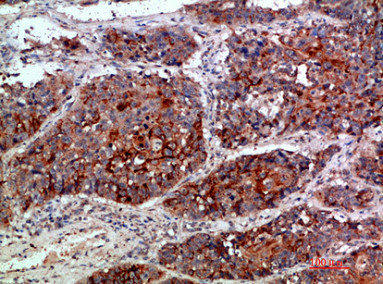 | Immunohistochemical analysis of paraffin-embedded human-lung-cancer, antibody was diluted at 1:200. |
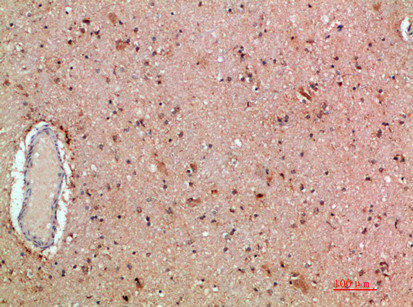 | Immunohistochemical analysis of paraffin-embedded human-brain, antibody was diluted at 1:200. |
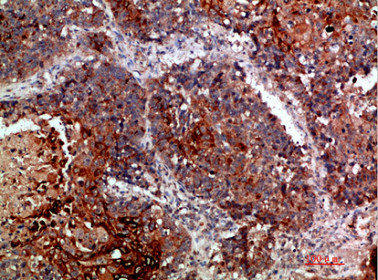 | Immunohistochemical analysis of paraffin-embedded human-lung-cancer, antibody was diluted at 1:200. |
| Synonyms: | Histone-lysine N-methyltransferase MLL (EC 2.1.1.43) (ALL-1) (CXXC-type zinc finger protein 7) (Lysine N-methyltransferase 2A) (KMT2A) (Trithorax-like protein) (Zinc finger protein HRX) [Cleaved into: MLL cleavage product N320 (N-terminal cleavage product of 320 kDa) (p320); MLL cleavage product C180 (C-terminal cleavage product of 180 kDa) (p180)] |
| UniProt Protein Function: | MLL: Histone methyltransferase that plays an essential role in early development and hematopoiesis. Catalytic subunit of the MLL1/MLL complex, a multiprotein complex that mediates both methylation of 'Lys-4' of histone H3 (H3K4me) complex and acetylation of 'Lys-16' of histone H4 (H4K16ac). In the MLL1/MLL complex, it specifically mediates H3K4me, a specific tag for epigenetic transcriptional activation. Has weak methyltransferase activity by itself, and requires other component of the MLL1/MLL complex to obtain full methyltransferase activity. Has no activity toward histone H3 phosphorylated on 'Thr-3', less activity toward H3 dimethylated on 'Arg-8' or 'Lys-9', while it has higher activity toward H3 acetylated on 'Lys-9'. Required for transcriptional activation of HOXA9. Promotes PPP1R15A-induced apoptosis. Chromosomal aberrations involving MLL are a cause of acute leukemias. Translocation t(1;11)(q21;q23) with MLLT11/AF1Q; translocation t(3;11)(p21;q23) with NCKIPSD/AF3p21; translocation t(3,11)(q25,q23) with GMPS; translocation t(4;11)(q21;q23) with AFF1/MLLT2/AF4; insertion ins(5;11)(q31;q13q23) with AFF4/AF5Q31; translocation t(5;11)(q12;q23) with AF5-alpha/CENPK; translocation t(6;11)(q27;q23) with MLLT4/AF6; translocation t(9;11)(p22;q23) with MLLT3/AF9; translocation t(10;11)(p11.2;q23) with ABI1; translocation t(10;11)(p12;q23) with MLLT10/AF10; t(11;15)(q23;q14) with CASC5 and ZFYVE19; translocation t(11;17)(q23;q21) with MLLT6/AF17; translocation t(11;19)(q23;p13.3) with ELL; translocation t(11;19)(q23;p13.3) with MLLT1/ENL; translocation t(11;19)(q23;p23) with GAS7; translocation t(X;11)(q13;q23) with FOXO4/AFX1. Translocation t(3;11)(q28;q23) with LPP. Translocation t(10;11)(q22;q23) with TET1. Translocation t(9;11)(q34;q23) with DAB2IP. Translocation t(4;11)(p12;q23) with FRYL. Fusion proteins MLL-MLLT1, MLL-MLLT3 and MLL-ELL interact with PPP1R15A and, on the contrary to unfused MLL, inhibit PPP1R15A-induced apoptosis. A chromosomal aberration involving MLL may be a cause of chronic neutrophilic leukemia. Translocation t(4;11)(q21;q23) with SEPT11. Belongs to the histone-lysine methyltransferase family. TRX/MLL subfamily. 2 isoforms of the human protein are produced by alternative splicing. |
| UniProt Protein Details: | Protein type:Methyltransferase, protein lysine; Transcription factor; Oncoprotein; Cell cycle regulation; EC 2.1.1.43; Methyltransferase Chromosomal Location of Human Ortholog: 11q23 Cellular Component: nucleoplasm; histone methyltransferase complex; cytoplasm; nucleus Molecular Function:identical protein binding; protein binding; protein homodimerization activity; zinc ion binding; AT DNA binding; unmethylated CpG binding; histone lysine N-methyltransferase activity (H3-K4 specific); chromatin binding; transcription factor activity Biological Process: transcription from RNA polymerase II promoter; establishment and/or maintenance of chromatin architecture; embryonic hemopoiesis; apoptosis; positive regulation of transcription, DNA-dependent; histone H3-K4 methylation; positive regulation of transporter activity; positive regulation of histone H3-K4 methylation; anterior/posterior pattern formation; negative regulation of cell proliferation; DNA methylation; protein complex assembly; positive regulation of transcription from RNA polymerase II promoter; circadian regulation of gene expression Disease: Hairy Elbows, Short Stature, Facial Dysmorphism, And Developmental Delay |
| NCBI Summary: | This gene encodes a transcriptional coactivator that plays an essential role in regulating gene expression during early development and hematopoiesis. The encoded protein contains multiple conserved functional domains. One of these domains, the SET domain, is responsible for its histone H3 lysine 4 (H3K4) methyltransferase activity which mediates chromatin modifications associated with epigenetic transcriptional activation. This protein is processed by the enzyme Taspase 1 into two fragments, MLL-C and MLL-N. These fragments reassociate and further assemble into different multiprotein complexes that regulate the transcription of specific target genes, including many of the HOX genes. Multiple chromosomal translocations involving this gene are the cause of certain acute lymphoid leukemias and acute myeloid leukemias. Alternate splicing results in multiple transcript variants.[provided by RefSeq, Oct 2010] |
| UniProt Code: | Q03164 |
| NCBI GenInfo Identifier: | 146345435 |
| NCBI Gene ID: | 4297 |
| NCBI Accession: | Q03164.5 |
| UniProt Related Accession: | Q03164 |
| Molecular Weight: | |
| NCBI Full Name: | Histone-lysine N-methyltransferase 2A |
| NCBI Synonym Full Names: | lysine methyltransferase 2A |
| NCBI Official Symbol: | KMT2A |
| NCBI Official Synonym Symbols: | HRX; MLL; MLL1; TRX1; ALL-1; CXXC7; HTRX1; MLL1A; WDSTS |
| NCBI Protein Information: | histone-lysine N-methyltransferase 2A |
| UniProt Protein Name: | Histone-lysine N-methyltransferase 2A |
| UniProt Synonym Protein Names: | ALL-1; CXXC-type zinc finger protein 7; Myeloid/lymphoid or mixed-lineage leukemia; Myeloid/lymphoid or mixed-lineage leukemia protein 1; Trithorax-like protein; Zinc finger protein HRXCleaved into the following 2 chains:MLL cleavage product N320Alternative name(s):N-terminal cleavage product of 320 kDa; p320 |
| UniProt Gene Name: | KMT2A |
| UniProt Entry Name: | KMT2A_HUMAN |







